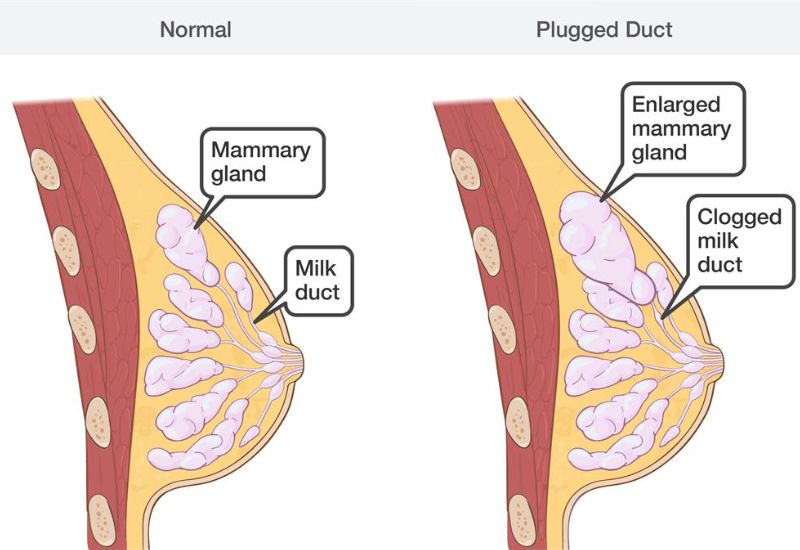Experiencing swelling, pain, and tenderness in the breasts can be a sign of a clogged milk duct following childbirth. This condition not only impacts the mother’s health but also disrupts the natural breastfeeding process for the baby. Understanding the causes and signs of a clogged milk duct can help mothers take timely action to manage the condition effectively.
1. What is a Clogged Milk Duct?
A clogged milk duct, or ductal obstruction, occurs when milk builds up in the ducts and is unable to flow out smoothly. This common issue among new mothers can lead to symptoms such as breast pain, swelling, and even the formation of hard lumps. In severe cases, it may develop into a breast abscess. This condition can hinder the breastfeeding process and may also affect the mother’s postpartum health. Early recognition of the signs and causes can be essential for finding a solution and preventing complications.
2. Causes of Plugged Milk Ducts
Several factors can lead to clogged milk ducts, especially in new mothers:
2.1 Overproduction of Breast Milk
One of the main causes of plugged milk ducts is an oversupply of milk. High levels of the hormone prolactin may cause the mammary glands to overproduce milk, creating more supply than the baby needs. When there is an excess, milk can build up in the ducts, leading to blockage and making it difficult for milk to flow out.
2.2 Early Postpartum Period
In the early days after childbirth, a mother’s body produces large amounts of the hormone oxytocin, which stimulates milk production and facilitates milk release. During this period, the body may not yet be in sync with the baby’s feeding needs, often resulting in excessive milk that leads to clogged ducts. Additionally, newborns may not latch properly at first, which limits their ability to drain milk effectively, further increasing the risk of milk duct obstruction.

Blocked milk ducts are common in postpartum mothers.
2.3 Pressure on the Breasts
External pressure from tight clothing, ill-fitting bras, or baby carriers can press on the milk ducts, making it harder for milk to flow. Over time, this pressure can cause milk to back up in the ducts, leading to blockages.
2.4 Incorrect Latching Technique
When a baby doesn’t latch properly, milk flow is hindered, causing milk to accumulate in the ducts. In some cases, newborns require guidance to latch effectively. A poor latch can lead to discomfort, and the resulting milk build-up in the ducts may cause blockage and breast pain.
2.5 Not Pumping Excess Milk
Regularly removing excess milk from the breasts can help prevent blockages. If a mother does not pump enough, milk may accumulate in the ducts. Additionally, an ineffective pump that does not fully empty the breast can also contribute to milk build-up.
2.6 Postpartum Stress
Stress and tension can interfere with milk production and flow by increasing levels of cortisol, which can negatively impact lactation. A mother under stress may experience more difficulty breastfeeding, which can lead to milk duct blockages.
3. Symptoms of a Clogged Milk Duct
Recognizing the symptoms early can help mothers seek timely treatment and avoid complications. Key symptoms of a plugged milk duct include:
– Breast Pain and Swelling: Hard and painful lumps around the breast are common indicators of a blockage. If the breast is tender, swollen, and hard to the touch, it may signal a plugged duct.
– Reduced Milk Flow: Clogged ducts can significantly slow milk flow or even cause it to stop. If a mother experiences difficulty extracting milk despite feeling fullness in the breast, this could indicate a blockage.
– Nipple and Breast Inflammation: In cases of a plugged duct, mothers may notice swelling, redness, and warmth around the nipple and breast. This can make breastfeeding uncomfortable and may indicate the need for intervention.

Swollen, painful breasts with palpable lumps are signs of a blocked milk duct.
4. How to Prevent Clogged Milk Ducts
To reduce the risk of plugged ducts, it’s essential to follow certain practices for effective breastfeeding:
– Ensure Proper Latch: Correct positioning and latch technique can help babies feed effectively and prevent milk from accumulating in the ducts.
– Pumping Excess Milk: After breastfeeding, any remaining milk should be pumped out. This can relieve pressure on the breast and minimize the risk of duct blockage.
– Choose Comfortable Clothing: Wear well-fitting bras and avoid garments that press tightly against the chest, especially when using baby carriers. Proper support without compression helps maintain milk flow.
– Manage Postpartum Stress: Stress management can play an essential role in maintaining milk flow and reducing the likelihood of plugged ducts. Talking to loved ones and practicing relaxation techniques can support emotional health, promoting a smoother breastfeeding experience.
If a mother experiences clogged milk ducts, there are several methods that may alleviate discomfort:
– Breast Massage: Gently massaging the breasts can stimulate milk flow and help clear the blockage.
– Warm Compresses: Applying a warm cloth to the affected area can promote circulation and relieve pain, making it easier for milk to pass through the ducts.
– Regular Pumping: Consistent pumping helps to reduce the pressure on the breast, preventing milk build-up and supporting a healthy breastfeeding process.

At Thu Cuc TCI, mothers are taught how to massage to prevent milk duct blockage.
Clogged milk ducts are a common concern for new mothers, and recognizing the symptoms early can lead to prompt and effective care. If you have additional questions or need assistance, the Thu Cuc TCI team is here to support you.








